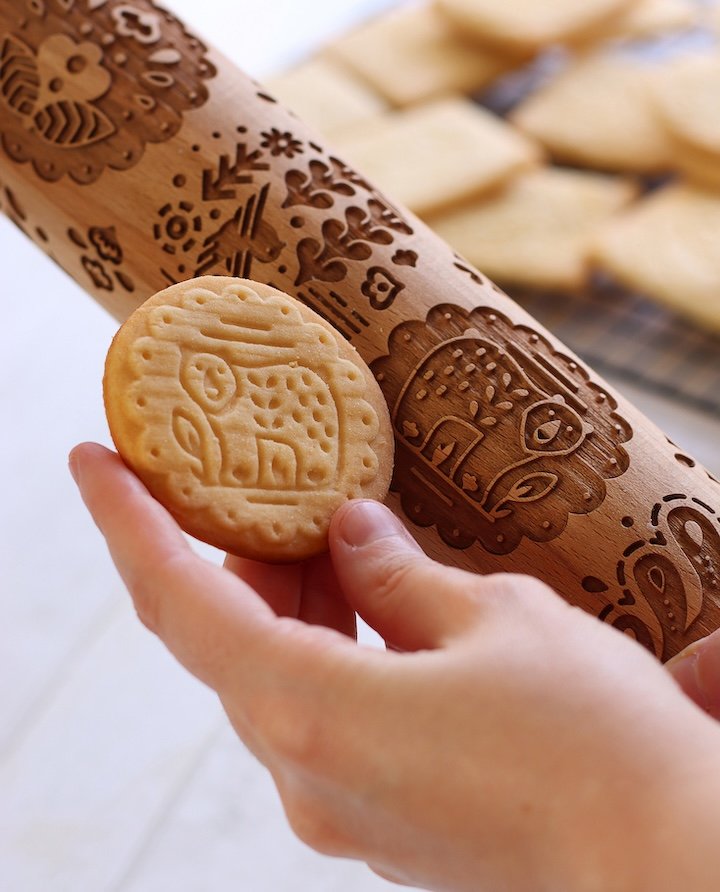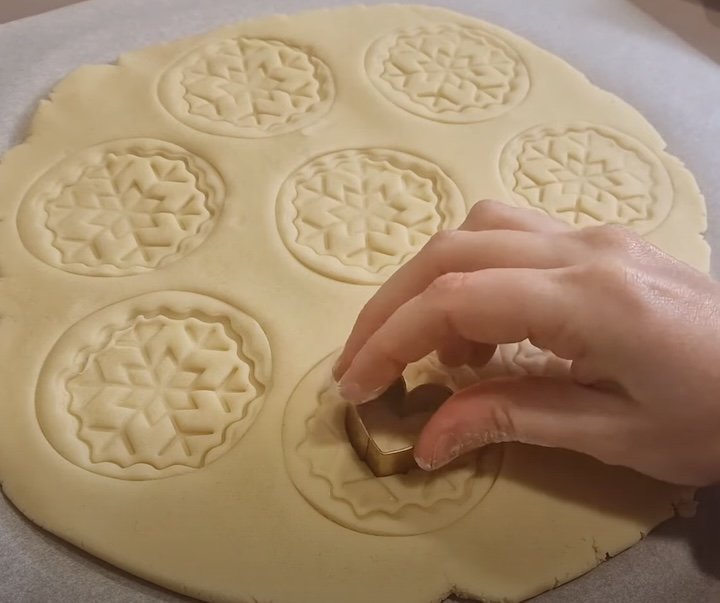Emma Fontanella’s 3-ingredient shortbread cookies. This is a “no-spread“ recipe—note how the cookies hold their shape perfectly when baked.
About My 3-Ingredient, No-Spread, Shortbread Cookies Recipe
Shortbread cookies are one of the most delicious holiday cookies, and they’re also probably the easiest to make! This recipe gives cookies that are super buttery, and literally melt-in-your-mouth. The base recipe has only three ingredients, yet still leaves lots of room to get creative—it works beautifully with a variety of mix-ins such as lemon zest, chocolate chips, dried fruit and nuts.
I designed the recipe so that these cookies hold their shapes perfectly as they bake. So, you can get creative making different shapes and designs and get stunning results!
Make a holiday shortbread cookie box easily by mixing and matching cookie cutters and cookie stamps to create different shapes and patterns.
This recipe is taken from my cookbook, Simple Pleasures.
Why this recipe works
I designed this shortbread recipe so that the cookies will hold their shapes and patterns beautifully when they bake. To enable this, there are a few differences to many traditional Scottish shortbread recipes.
In particular, I’m using powdered sugar (icing sugar) rather than the traditional granulated sugar. The powdered sugar gives the cookies a fine texture, and helps them retain a precise shape as they bake. It does this in a couple of ways.
First, the fine powder dissolves into the butter quickly. This is important because we want to work quickly so as not to incorporate air into the mixture, otherwise the cookies will puff up and not keep their precise shapes when they bake.
Second, powdered sugar contains corn starch (to stop the powered sugar setting solid in its packaging). This gives us another benefit for the recipe. The polysaccharides that make up cornstarch interrupt the gluten network in the shortbread dough, reducing its elasticity, and helping to prevent the cookies from spreading out as they bake.
What is the secret to making good shortbread?
It’s the combination of lots of good, salty butter and sugar which gives shortbread cookies their amazing flavor. Use the best quality butter you can find – the better it is, the more delicious your shortbread will be. Under no circumstances use “spreadable from the fridge” products. You must use butter that is solid when in the fridge.
What is the difference between a butter cookie and a shortbread cookie?
The difference between butter cookies and shortbread cookies is the amount butter in the recipe vs the amount of sugar. Butter cookies typically are made using more sugar and less butter than shortbread. Shortbread cookies contain more butter, which gives them their amazing crumbly, melt-in-your-mouth texture.
What are common mistakes when making shortbread?
The most common mistakes when making shortbread are over-working the dough, and incorporating too much flour. The less you work the dough, the more crumbly and melt-in-your-mouth your shortbread cookies will be. When you’re working the dough, try to avoid incorporating extra flour, because it will throw the recipe off and make the cookies tough.
Get creative with cutters, stamps, molds, and embossed rolling pins
By mixing and matching different cookie cutters, cookie stamps, molds and more, you can make a stunning range of unique cookies. For example, combining a circular cookie cutter with a snowflake stamp makes it easy to create snowflake shortbread cookies.
Combine a circular cookie cutter and snowflake stamp to make snowflake shortbread cookies
Using a snowflake stamp to make snowflake cookies
Then, you can take the idea a stage further to cut out holes, to make sandwich cookies where the filling e.g. jam, shows through.
Using a small heart shaped cookies cutter, to turn the cookies into lids for sandwich cookies where the filling shows through.
Or, use cookie molds to create beautiful, intricately patterned cookies in a few seconds. For example, this pine cone cookie.
Use cookie molds to create stunning cookies with intricate designs in a few seconds.
Some ideas for shortbread mix-ins / additions
Shortbread is really flexible when it comes to mix-ins and other additions. I love adding pistachios or chocolate chips. Dried cranberries and pecans is a combination that work well, and is very festive. You could also try peanuts or walnuts and raisins. Chopped up pieces of preserved ginger in syrup (stem ginger) are another delicious add-on.
Another great addition is to scent the shortbread using citrus. Grated lemon, orange and clementine zest all work really well. Similarly, if you like spices, adding vanilla extract, ground nutmeg, ground cinnamon or ground ginger can be delicious.
Sprinkling the shortbread with granulated sugar before baking is also delicious and traditional.
Finally, dipping shortbread in melted white, milk or dark chocolate is a delicious addition.
Make Ahead and Freeze
Once the shortbread cookies have been baked and are fully cool, store them rigid airtight containers. They will keep for up to 5 days at room temperature. They can be frozen in the airtight containers for up to 3 months. To defrost, take the cookies out of their containers and place on a wire rack at room temperature for about an hour.
Unbaked shortbread dough freezes well. Covered tightly with plastic wrap and freeze for up to 3 months. Defrost the unbaked dough in the fridge over night before rolling out and shaping the cookies.
EQUIPMENT
Stand mixer (recommended but not required)
Cookie cutters (optional)
Cookie stamps (optional)
Embossed rolling pin (optional)
INGREDIENTS
(This recipe yields about 20 to 30 cookies, depending on size)
8 tbsp (1 stick / 115g) salted butter, at room temperature. (Use real butter that is solid when in the fridge. Do not use “spreadable from the fridge” products)
½ cup (60g) powdered sugar
1¼ cups (175g) all-purpose flour (also known as “plain flour”)
Mix-ins/Add-ins
If you want to add mix-ins, such as pistachio nuts, use around 2oz (60g). The precise amount is up to you.
INSTRUCTIONS
Prepare the baking sheet
Line a baking sheet with parchment paper.
Combine the ingredients
To a stand mixer with a paddle attachment, add the soft, room-temperature butter and the powdered sugar. Beat until the mixture is smooth. Add the flour and mix to combine.
The dough will seem dry at first but keep mixing; eventually the dough will come together. Stop mixing when there are no more spots of flour, and the dough is smooth. Alternatively, you can make the dough using a rubber spatula and your hands.)
Troubleshooting the dough. First, make sure you used the right kind of butter—you must use butter that is solid when in the fridge. If you use a product that is “spreadable from the fridge”, the recipe will not work. Also, remember, the dough will seem dry at first, so you need to make sure you really give it a chance to come together, working it with your hands. If the dough refuses to come together, though, and is too crumbly, it might be that the water content of your butter or your flour is very low (yes, both butter and flour contain water). In which case, add a couple of teaspoons of water. That should allow the dough to come together.
Optionally, add the mix-ins
If you’re adding mix-ins, stir them into the dough, and make sure they’re evenly distributed. (See the section “Some ideas for shortbread mix-ins / additions” above for suggestions.)
Roll out the shortbread
Gather and transfer the dough to a lightly floured work surface, and using a rolling pin, roll out the dough to about ½-inch (1.25cm) thickness. (I like to use an embossed rolling pin, but it's not necessary.)
Shape the cookies
Cut into whatever shapes you prefer (I like circles and rectangles) and transfer the cookies to the prepared baking sheet.
Get creative with mixing and matching cookie cutters, cookie stamps, cookie molds and embossed rolling pins. See the section “Get creative with cutters, stamps, molds, and embossed rolling pins” above.
Chill the cookies in the fridge for at least 45 minutes or in the freezer for 20 minutes.
Preheat the oven
Preheat the oven to 350°F (180°C).
Bake the shortbread
Bake for 12 to 15 minutes or until lightly golden. Remove from the oven and let them rest on the baking sheet for 15 minutes before transferring to a wire rack and allowing them to cool completely.
Watch the video for more tips
Hi! I’m Emma Fontanella. Here you’ll find trusted, tested recipes to satisfy your baking addiction and carb cravings. Learn more…
Tried one of my recipes? Please let me know on Instagram (@emmafontanella) or TikTok (@emma.fontanella)! Hashtag #emmafontanella
Search for another recipe…







